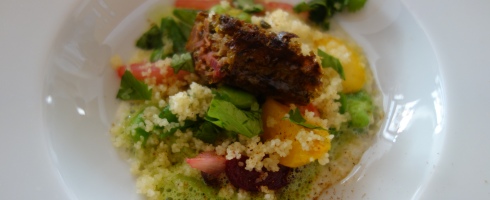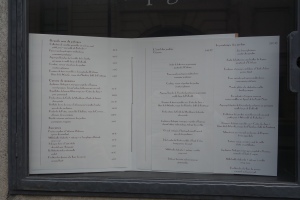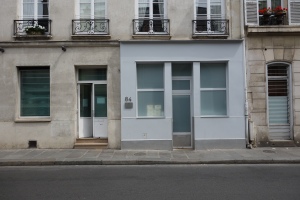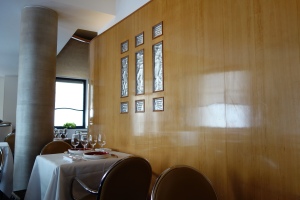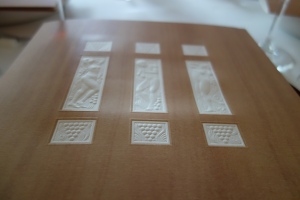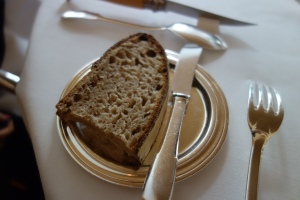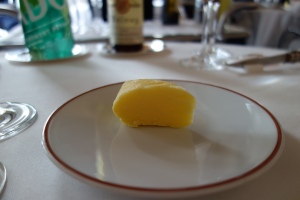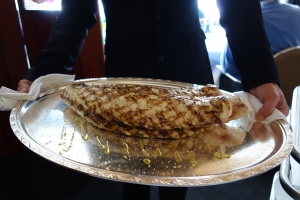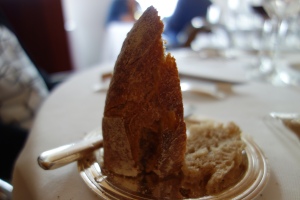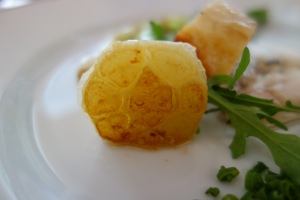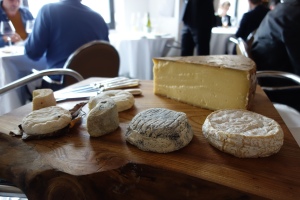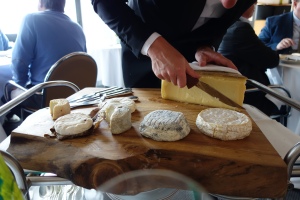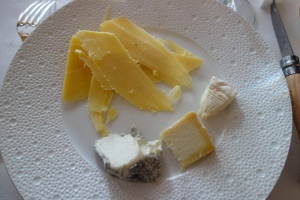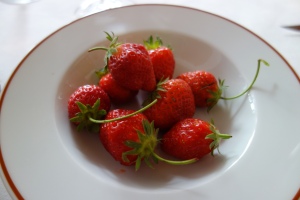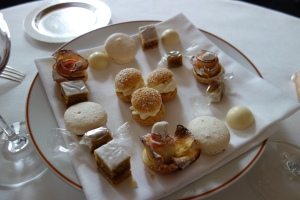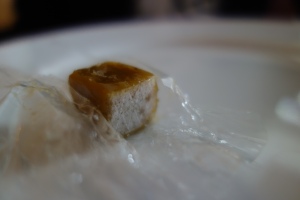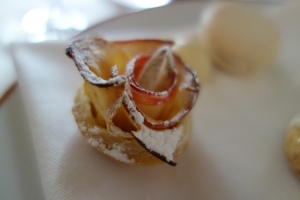- Rating: 18.5/20
- Address: 84 Rue de Varenne, 75007 Paris, France
- Phone: +33 1 47 05 09 06
- Price per pax (after tax + tip, two half-bottles split among three): €380 ($518 at 1 EUR = 1.36 USD)
- Courses: (14 main / 17 total): 2 amuses / 12 savory / 1 cheese / 1 dessert / 1 mignardises
- Price/Main Course: $37
- Value: 1.5/5
- Dining Time: 240 minutes
- Chef: Alain Passard
- Style: Vegetable-Focused
- Michelin Stars: 3
I was back. 2 years after a life-changing meal at L’Arpege (my first) in the winter of 2012, where I was served a marvellous parade of dishes (a perfectly executed salad, Cevennes onion gratin, vegetable ravioli, Harlequin Gardener with vegetable sausage, and a superb millefeuille) I returned to the minimalist dining room, with the triptych to Bacchus hanging over the dining room. It was as minimalist as I had remembered it, laminated wood, functional rather than luxurious chairs, and simple table arrangements. The colours, would come not from the decor, but the vegetal stars gracing our plates. And what colour!
One of the pleasures of dining out, is that each great restaurant is unique in its own way. We had dined the previous week at The Fat Duck, where the greatness of the restaurant was in the sheer amount of thought that went into every little detail of the dish, from theoretical construction to the actual assembly and cooking of the dish. (see The Fat Duck Head Chef Jonny Lake talking about how they conceptualised the magnificent Lamb dish, to see what I am talking about). Alain Passard gives each of his dishes equal thought, tasting and refining his raw vegetable products from his farms before serving them. (See the graphic novella: In the Kitchen with Alain Passard) But where at The Fat Duck, portions are measured to scientific accuracy and dishes refined and re-refined in an R&D lab months before they go on the tasting menu, Passard’s improvisational cooking style draws from his love of music, and he is much more willing to let the testimony of his ingredients speak for themselves.
I had also dined at 1* Hedone in London the previous week, and though I found the ingredients impeccable, I found myself enjoying the minimalism at L’Arpege more than at Hedone. The two both prize the testimony of the ingredient, the voice of the ingredient above all else. So why did I enjoy the minimalism at L’Arpege more? I can only think that it is an intellectual response to a great chef’s vision. Passard’s vision of a vegetable cuisine, with vegetable sausages, top-class ravioli, the revaluation of beetroot in his sushi (improved over the winter version, which had an unnecessary dab of wasabi, now gone) – is compelling, above even a chef that demonstrates catholic knowledge over the provenance of a wide range of ingredients. Restriction of the option-space of ingredients to just vegetables, gives the chef that much more to do, to transform and subvert our expectations. And Passard is a great chef, one whose skills are well-suited to the task. In the end though, it is a matter of taste whether one would better enjoy a first-rate meal of the stereotypical ingredients – amuse, vegetables, seafood, red meat, dessert – or if one would better enjoy a first-rate meal that up-ends and subverts those expectations.
And yet L’Arpege is not perfect. Part of the reason I enjoyed it less than in winter two years ago: many of the tropes and gestures from my winter meal were repeated. Beetroot sushi was repeated, as well as the veloute, and the ravioli, with the Harlequin gardener, roast chicken, millefeuille. As it was only my second meal at L’Arpege, I had been hoping to try a broader range of Passard’s cooking. Perhaps I should have ordered the vegetable tasting option, or gone carte blanche, instead of the grand menu. A second possible reason: I found the grand menu very similar (in that only one dish was completely changed – the blue lobster substituted for the potatoes) from the lunch tasting menu. For €200 Euros more (€140 vs €340), it left me feeling a bit short-changed. If there is a better way to ensure that lunch patrons don’t order your grand tasting menu at lunch, I’d like to hear it. Perhaps that is the point – the grand menu being for tourists rather than locals, who know the ins-and-outs of navigating a meal at L’Arpege.
Was it still a first-rate meal? Yes. Was it worth the money plonked down this time? I am on the fence on this one, for both the considerable repetition, and the feeling of €200 misspent. I have heard meals at L’Arpège being described as expensive gambles. When a Passard meal comes off, it is truly magnificent, an eighth wonder of the world. When it doesn’t, it falls to earth with a resounding thud. Among my friends who have had the fortune to dine at L’Arpege, I have noticed two contrasting reactions – no one sits on the fence – the first, if fortune smiles, being that one is a convert to Passard’s vision. The second, if ill-starred, is that one forswears off L’Arpege. Having had both experiences, I now understand both points of view. The arras is drawn, I now look forward to a third meal at L’Arpege with both the hope of transcendence, and the knowledge that I might yet be disappointed.
Rating: 18.5/20
Les jardins en Juin (grand tasting)
(All listed dish descriptions in French, non-listed dish descriptions in English)
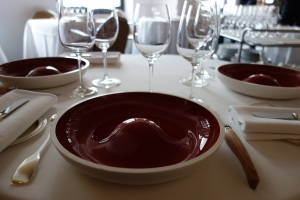
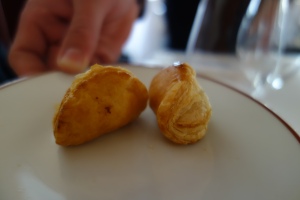 1. Mint/carrot puff pastry (4/5)
1. Mint/carrot puff pastry (4/5)
-
- A nice, immediate amuse, served seconds after we were seated at the table
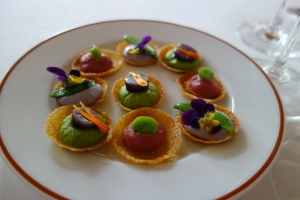 2. Vegetable tartlets: Beetroot/Green Peas/Purple Potato (4/5)
2. Vegetable tartlets: Beetroot/Green Peas/Purple Potato (4/5)
-
- An amusing permutation carousel of vegetable tartlets: (A) Green pea puree topped with a piece of potato (B) purple potato puree with green pea on top (C) Beetroot puree with a green bean on top.
-
- With Jean-Yves Bordier butter (5/5). Salty, real depth of flavor.
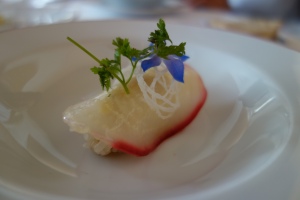
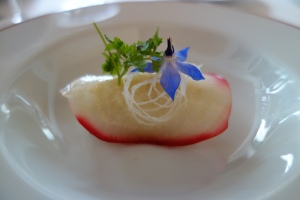 3. Sushi de betterave au geranium (4.5/5)
3. Sushi de betterave au geranium (4.5/5)
-
- moutarde d’Orleans
- This version was better than the one I had two years ago, which then had wasabi overpowering the sweet beetroot. Here the wasabi had vanished, and was replaced by a pleasing geranium oil, which gave it a appetising floral fragrance to accompany to smooth sweetness of the beetroot.
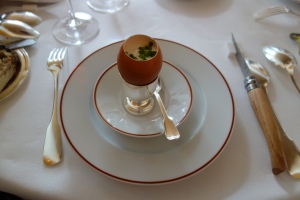
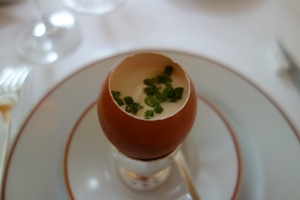 4. Chaud froid d’oeuf au sirop d’érable (4.75/5)
4. Chaud froid d’oeuf au sirop d’érable (4.75/5)
-
- 4 épices & vinaigre de Xeres
- The L’Arpege egg, which I had personally made, with David Kinch’s Manresa recipe
- I had also tried it (the Arpege egg) at Manresa a couple of months earlier, in April 2014. There it is lighter, the maple syrup goes padfooted on the sherry vinegar cream, (5-6 drops in the Manresa drizzle). At L’Arpege, the maple syrup found its way into the poached egg yolk – which was sweetened. Perhaps the syrup was whipped straight into the egg yolk this time?
- As I mentioned on my Manresa write-up, I prefer to add more maple syrup to accentuate the sweet-sour contrast with cold sour sherry-vinegar cream. Here the contrast was sweet-warm (syrup-egg, somehow mixed) vs cold-sour (sherry vinegar cream), with chives, 4-spice, salt, as supporting cast.
- In “It Must’ve Been Something I Ate”, the food critic Jeffrey Steingarten details the quatre-epices:
“This common French combination of four spices, used especially in charcuterie, typically includes black or white pepper, nutmeg, cloves or cinnamon, and ginger, and is sold already prepared in bottles. Passard makes his own, using white pepper [Sarawak?] and going heavy on the ginger. To follow him, use a (clean) electric coffee grinder, the kind with a whirling horizontal blade, to pulverize 2 tablespoons white peppercorns. Add 1/4 teaspoon ground clove, 3/4 teaspoon ground nutmeg, and 2 teaspoons powdered ginger, and grind them all together until the mixture is extremely fine.”
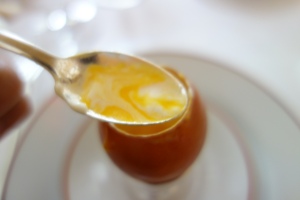
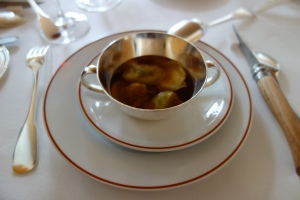
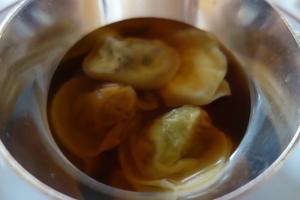 5. Fines ravioles potageres multicolores (5/5)
5. Fines ravioles potageres multicolores (5/5)
-
- consomme printanier
- A stunning smoky, green bean consomme that tasted intensely of the bean itself, with 4 types of ravioli: carrot-rose, turnip-basil, asparagus-vervain (AKA asparagus-verbena), and pois-gourmand-ail (AKA pea-garlic). Each primary vegetable (carrot, turnip, asparagus, pea) was perfectly paired with the secondary herb (rose, basil, verbena, garlic). Spectacular. 5 elements – consomme, and 4 raviolis of different pairings, yet a complete garden of flavors. To me, this is a dish one cannot tire of.
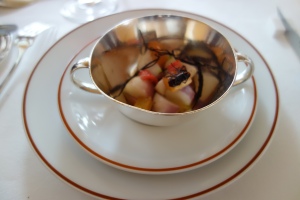
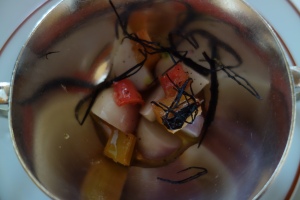
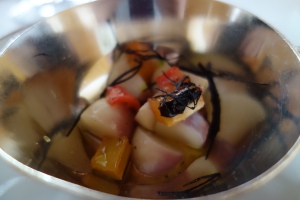 6. Couleur, saveur et parfum des jardins (4.75/5)
6. Couleur, saveur et parfum des jardins (4.75/5)
-
- creation ephemere
- Purple turnip, rhubarb, purple basil. Pairing ingredients with similar colour profiles, or chromatic cooking. Here the sour rhubarb offset the sweeter purple turnip. The surprise of the dish was an intense purple sauce, right at the very bottom of the bowl. Where had it appeared from? It was intensely sweet, like root-vegetable candy. The pairing with the last bite of rhubarb was sublime.
- Jeffrey Steingartenin It Must’ve Been Something I Ate details the probable origins of that purple sauce – a version of jus de legumes, probably made from reducing the jus de navet (turnip) and adding honey –
“Jus de legumes can mean a variety of things; at L’Arpege, it is light and sweet, and relies mainly on the wealth of vegetable juices left over from preparing various dishes. Here we must start from scratch. To make 2 1/2 cups of jus, enough for both recipes: In a 4-quart saucepan put 10 cups of roughly chopped vegetables (carrots, celery, onions, black radishes, turnips, leeks, rutabaga, and in the winter, celery root). Cover with cold water, about 6 cups. Add 2 tablespoons of salted butter. Bring to a simmer, partially cover, and cook for 40 minutes. Strain the liquid and reduce it by about half to 2 1/2 cups. Taste it and smile. Add any pan juices left over from cooking the red onion and the celery root”.
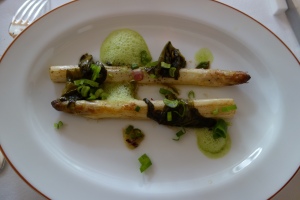 7. Asperge blanche de la vallee de la Sarthe (4.25/5)
7. Asperge blanche de la vallee de la Sarthe (4.25/5)
-
- geranium & oseille large de Belleville
- Roasted white asparagus, sorrel, and bay leaf oil. Juicy white stalks, really top class white asparagus. I however did not find the accompaniments of bay leaf oil and sorrel to add much aroma to this dish, and there was a pickled leaf (bay leaf? seaweed?) the slight sourness of which was out of place in the dish.
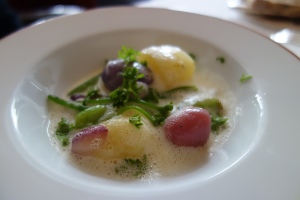
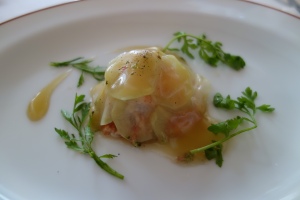
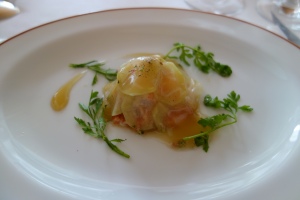 8. Bouquet de homard breton acidule au miel (3.75/5)
8. Bouquet de homard breton acidule au miel (3.75/5)
-
- transparence de navet nouveau
- Sweet and sour sauce, made of honey, lime, sherry vinegar, with carpaccio of turnip, and Breton lobster (AKA homard bleu, blue lobster) underneath
- a €200 dish (this was the one completely changed dish from the €140 lunch tasting menu). So how was it? The sweet and sour sauce was truly superb, tasting complex. But I was not taken with the cold chunks of lobster, underneath the tender slices of turnip. It resembled a cold preparation of sweet-and-sour seafood salad from a Chinese banquet, and I failed to detect the quality differential in the Breton lobster that would elevate this dish.
- A massive disappointment.
- http://www.finisterebrittany.com/discover/breton-lobster
The displayed monkfish

 9. Asparagus-onion veloute (4/5)
9. Asparagus-onion veloute (4/5)
-
- Smoked ham whipped cream, cold
- Veloute good in sweetness, offset by smoked ham cream.
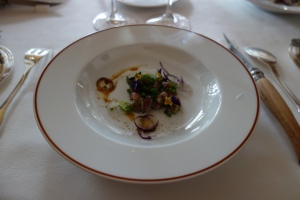
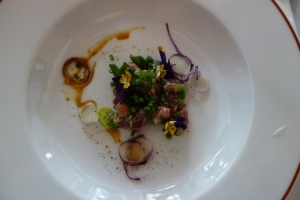 10. Tuna tartare, vervaine, fava beans (3.5/5)
10. Tuna tartare, vervaine, fava beans (3.5/5)
-
- Tastes of soy sauce, without further perceptible modification, which was an Asian touch that seemed perfunctory. Solid, though not mindblowing.
I really like crusty ends, and thanks to maitre d’ Hélène Cousin for noticing that.
“He Has Left Us Alone but Shafts of Light Sometimes Grace the Corner of Our Rooms…“
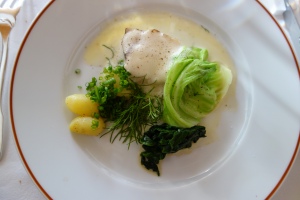 11. Peche cotiere du Golfe du Morbihan au <<Cotes du Jura>> (4.75/5)
11. Peche cotiere du Golfe du Morbihan au <<Cotes du Jura>> (4.75/5)
-
- pommes de terre nouvelles
- grilled monkfish from Brittany, which was a classic. New potatoes, which had a nice sweetness, along with springy monkfish, cabbage, spinach, and a vin jaune sauce. Very classic, and executed beautifully.
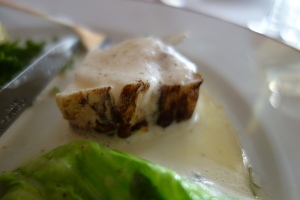
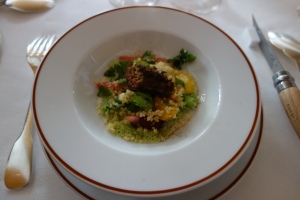
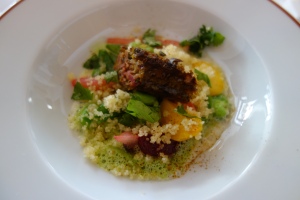
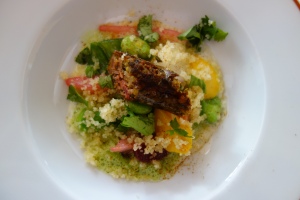 12. Jardiniere Arlequin & merguez vegetale a l’harissa (4.25/5)
12. Jardiniere Arlequin & merguez vegetale a l’harissa (4.25/5)
-
- fenouil selma, courgette fleur, trilogie de carottes, artichaut violet…
- I was served almost the same dish at my last meal here, and there the winter vegetables, bursting with sugar, sung with a true harmony of flavors. Here the vegetable sausage was a bit rougher and drier than I remembered. The vegetables seemed a bit less flavorful. To be honest, if I wasn’t served a sublime version two years ago, I wouldn’t have known what the fuss about this dish was all about.
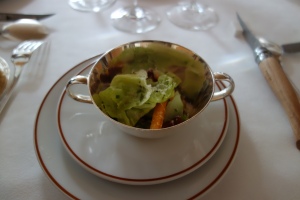
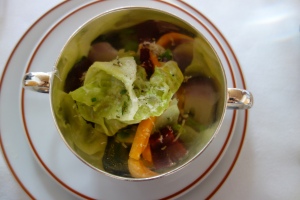 13. Vegetable minestrone, chorizo, parmesan (4/5)
13. Vegetable minestrone, chorizo, parmesan (4/5)
-
- I think my personal joy of a L’Arpege meal is just being able to take in the sweetness and unreal quality of the produce from Passard’s farms. A real sweetness in the carrots, and peas- peas that are perhaps less juicy that those at Manresa in California or Etxebarri in Basque country, but so giving to the bite, and the two halves sliding off each other so easily. Very tender, excellent produce.
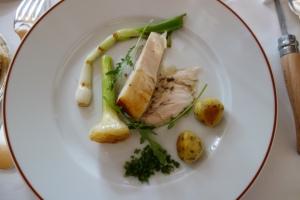 14. Grande rotisserie d’heritage Louise Passard (4/5)
14. Grande rotisserie d’heritage Louise Passard (4/5)
-
- eleveurs de nos regions
- Chicken, fig-leaf oil, potato gnocchi
- Good. Passard likes to cook his chicken more than other chefs, and this was a bit tougher than I would like. But it was more tender than the winter version.
- ses fantaisies
- The cheese cart: Bernard Antony 48 month Comte (5/5), Camembert from Normandy, Banon cheese from Provence, dry goat cheese from Savoy, Bonde en Gratin.
- What is there about the Bernard Antony Comte that hasn’t been said? Nothing. But I’ll say it again: a dry, nutty, textured shavings of a scarcely-sandy, sweet, cheese. Every bite reveals a food complete in itself. May it repose, self-satisfied. Masterpiece (5/5).
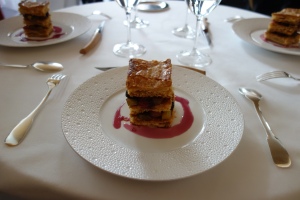

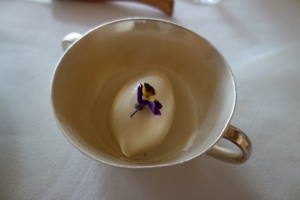 16. Millefeuille rhubarbe <<vintage>> a l’angelique officinale (5/5)
16. Millefeuille rhubarbe <<vintage>> a l’angelique officinale (5/5)
-
- sirop rose
- Thank the Gods Passard among the top Paris chefs still prepares his millefeuille (I could not find it on the menu at L’Ambroisie or Ledoyen). It is perfect. The flaky pastry cuts beautifully, and with an audible crunch. Rhubarb millefeuille with sour cherries, and then paired off with an intensely floral rose ice cream, which brought to mind the intensely floral geranium oil in the beetroot sushi that our meal started off with.
-
- macaron, nougat, tuile, bouquet de roses®, pop-corn…
- Angelique (sinensis? danggui?) caramel was very interesting – the bitter herbal taste going well with the sweet stickiness of caramel; choux, sweet, macaron, and the mini bouquet of roses tart.
Other Notable Write-ups:
- L’Arpège (2004): A trip report to Arpege by the most delightful “lxt”, who has a most distinguished palate, an impressive knowledge of caviar, and an unfortunate run-in with L’Arpege’s dungeon room (http://mouthfulsfood.com/forums/index.php/topic/1088-arpege/)
- On the dungeon room: “I turned abruptly, so that the courteous distance between the hostess and me was slightly reduced, and politely inquired whether it was possible to be seated upstairs. “Since you made a reservation at the last minute, this is all we can do,” followed the firm response from the slim, fragile-looking young woman who seemed not to be inclined to change her mind. Our insistence that we indeed cared enough to make a reservation two months in advance by both mail and phone and were forced to reschedule due to special circumstances didn’t seem to soften her heart, and we were seated in the dungeon at the farthest table from the entrance with a promise, however, to be moved upstairs in case any of the more privileged diners wouldn’t object to dining downstairs or would finish their dinner early.After the hostess disappeared and we were left alone for a short while, I was stunned to recognize the smell of mold, of a basement, of an old building flooded for a long time: a smell of rot and age that would undoubtedly interfere with the appreciation of food, since when the nose fails, 80% of the ability to taste is lost. The thought crossed my mind that the disparity in comfort between good tables and bad tables – that is, the difference between the upper and lower rooms – while offset by genuine chords of compassionate sighs from the staff, was so much more extreme than at similar establishments, that perhaps it should place on Arpège the obligation to inform a diner in advance of his seating assignment.“Do you sense the smell of …” I started saying, lifting my eyes up at my consort to find out whether he detected an unpleasant odor as well, and stopped in the middle of the sentence with a chill running through my body as I saw him turning pale with a dew of cold sweat on his forehead, taking me back to the recent past in a momentary flash and a sudden burst of memory where I was terrified watching a neuro-surgeon, who happened to be on the same plane with us, gently chuckle, mumbling “It’s always big men who faint,” while taking my husband’s blood pressure.We were very apologetic on our way out. “The last thing we all want is me passing out in your restaurant,” laughingly added my consort halfway out, but… apparently this last argument was quite convincing, and a cozy table in the main room across from the entrance was kindly offered and accepted.”
- On caviar quality: “Caviar osciètre royal d’Iran (nouvelle pêche).
When a bowl of white, thick and smooth, creamy and lightly frothed Jerusalem artichoke velouté, whose gentle flow was disturbed only by the dark beads of the scoop of Iranian Royal Caviar in the center, was placed in front of me, before I attempted to unravel the flavors of this pictorial dish and examine the quality of the caviar, a reminiscence of the first time I tried beluga – the world-class 000 malossol caviar (from Astrakhan, aged for two months), with large (about 3 millimeters in diameter) beads, leaving an unforgettable sensation as little black pearls popped lightly when pressed against the roof of my mouth with my tongue, releasing, just like good butter, a soft, rich and exquisitely delicate flavor with a hint of sweetness, a slightly nutty flavor and a clean, smooth finish – brought back a pleasant feeling.With current problems relating to overfishing in the Caspian Sea and trade restrictions on Russian sturgeon, I hardly expected to see beluga on the menu, though the price of the dish prompted high expectations, but I anticipated finding excellent quality osetra and was surprised and disappointed after examining it.Iranian caviar has several disadvantages compared to Russian (specifically, along the Volga, “the mother of sturgeon rivers” –Inga Saffron) that may affect the quality and taste, in my opinion: 1) Osetra from the cooler waters of the southwest shores (the coast of Iran in the Caspian Sea) doesn’t develop the complexity of flavors, ranging from fruity to nutty, lingering pleasantly in the mouth, for which it is praised. 2) There is a fine art to producing top-quality caviar that varies from fish to fish, applied depending on whether the eggs are perfectly ripe, immature or too mature, requiring different curing techniques to bring out the best in the roe. These skills were mastered over the centuries in Russia and were passed from generation to generation assuring the high level of integrity of the product, whereas the consumption of both sturgeon and its roe and even touching the fish were not allowed by Islam, since sturgeon doesn’t have scales, so that Iranian participation in the caviar trade has really been only a 20th-century phenomenon.The dark-gray-to-brown color of the beads on my plate, indicating a stronger flavor (lighter, golden color osetra is more delicate), their medium size, uniformity and shine were very attractive, and I anticipated a little burst as I put several pearls in my mouth only to be disappointed by a sluggish, soggy result lacking the distinctive “pop,” and sadly, a very salty, straightforward flavor, which is an indication of inferior quality.Lightly salting caviar, as with Russian Malossol, is the desired treatment for the best eggs, allowing no more than 3% salt in relation to the egg weight; lesser grades can have up to 10%. Mixing salt with borax (an old method utilized in Russia to simulate the 16th century approach where caviar was penetrated by borax from the soil, near the Caspian Sea, in which bags with caviar were buried to age), results in caviar with a more rounded, sweeter flavor. There were none of these characteristics in the caviar at Arpège. In fact, it tasted as if it were pasteurized, which sometimes is done after curing and packing to prolong caviar’s shelf life, but which permanently alters the eggs’ delicate protein, resulting in sogginess.“Passard should change his supplier, but this dish is excellent,” said my consort, referring to the caviar, as he mixed it thoroughly with the velouté, and took a spoonful of the gently warm mixture. Indeed, despite the name of the dish, caviar was not the central element in this composition. The suave, rich velouté (slightly warmer than room temperature) was so intense in its gentle flavor that it was as if the last drop of life had been drawn out of the vegetable, revitalizing the creamy liquid and permeating it with a subtle, softly sweet and precise flavor. As the caviar beads spread out in the liquid and contributed their salty intonations, the sweetness seemed to blend naturally with the salt without being suppressed. It was a nice progression of flavors from slightly sweet to salty-sweet, with a gentle amalgamation of all components giving the dish its very structure, which didn’t shock, just pleased. Though the title, accenting a less-than-perfect component, was misleading, the ultimate result of the whole dish seemed to transcend the ingredients.” - On the same thread, a poster named Orik compares Passard’s vegetable cuisine with his cuisine in the 90s: “lxt,I don’t have my summary of the last meal at Arpege in front of me, but vegetables vs. meat is not a primary concern. I can only remember having eaten a few meat dishes at the 1990s Arpege (wild hare once, a couple of amazingly good duck preparations and the pigeon, never beef, pork or lamb). Their seared foie gras was not an interesting dish – scallops, lobster and fish, truffles and vegetables were always the stars.The notes from our last meal there are not in front of me, but let me see if I can recall:1. Luxury ingredients – the menu still features homard breton and caviar, so there is no real movement away from these ingredients. However, the lobster in yellow wine used to include truffle shavings (otherwise it was identical) and sell for half its current price. Also, there was previously a wonderful truffle and parmesan soup, in our last visit this was replaced with caramelized onion gratin. I’m not going to argue with anyone claiming that an onion can bring him or her the same pleasure as truffles and parmesan – this is a subjective matter, but it surely brings pleasure to the restaurant’s accountant, as both dishes sell for about the same price.2. Quality of ingredients, complexity of preparation – also in our last visit, we ordered a mushroom soup. Sivan tasted it and said “well, this is most certainly a very plain mushroom soup”. The following day we saw passard offering the same soup at some sort of a food event, together with the recipe – champignons, stock, cream… Nothing different from how you would have prepared cream of mushroom. 64 Euros, I think (or was it 48? ridiculous, in any event).3. Wine prices – the restaurant can do as it pleases, but there are some cases where prices in Euro are not much lower than they were in Francs…
4. Boredom – the egg, both lobster preparation, a couple of variations on the caviar theme (sometimes it’s with avocado), a very large whole roasted bass, when available, even a slightly modified version of the scallop dish (I think the cabbage was only present in the lobster with yellow wine before) have been on the menu for many years. If you look at the cuisine of the 1990 [sic] and the current cuisine, you’ll see just how much of the supposed change is purely marketing and cost cutting.
5. Cheese service – used to be exceptional, has become miserable, but this isn’t unique to Arpege.
In short, from a relatively casual 3 star, serving innovative cuisine at very low prices (I actually have a check for 2800 FF including 1000 FF for wine), Arpege has become one of the most expensive restaurants in France, yet its cuisine, service and decor did not evolve significantly. Still a destination for someone who hasn’t tried Passard’s cuisine. Fortunately we were never seated in the basement 😉 “
- L’Arpège (2006): A review from Vedat Milor. http://www.gastromondiale.com/2008/10/arpege.html
- “Is Alain Passard a near magician who can cook with his left hand, so to speak, and still concoct absolutely perfect dishes? Probably. Few can compete with him to create such elegant and amazingly harmonious dishes, which look simple on the plate but reveal so much intensity and complexity with each bite without losing focus. His Fin gazpacho a la moutarde onctueuse d’Orleans, Homard des Iles Chaussey “Arpege”, and Turbot de Bretagne are all culinary masterpieces. They are masterpieces because the raw materials are perfect or near perfect (somehow the lobster meat had perfect texture but lacked the sweetness we associate with great blue lobster), the balance between acidity, nuttiness and sweetness in each dish is optimum, and all of these dishes are original and express the inimitable style of a great chef in bringing out the full range of flavors hidden in his ingredients without torturing them or subjecting them to senseless experiments with texture, as many Passard imitators do. In fact, when he prepares a risotto du potager with various root and other vegetables from his garden, one feels that all our preconceived notions about luxury and “grand dining” can be laid to rest for a while. Sometimes the most simple (but not simplistic) is also the most decadent.”

